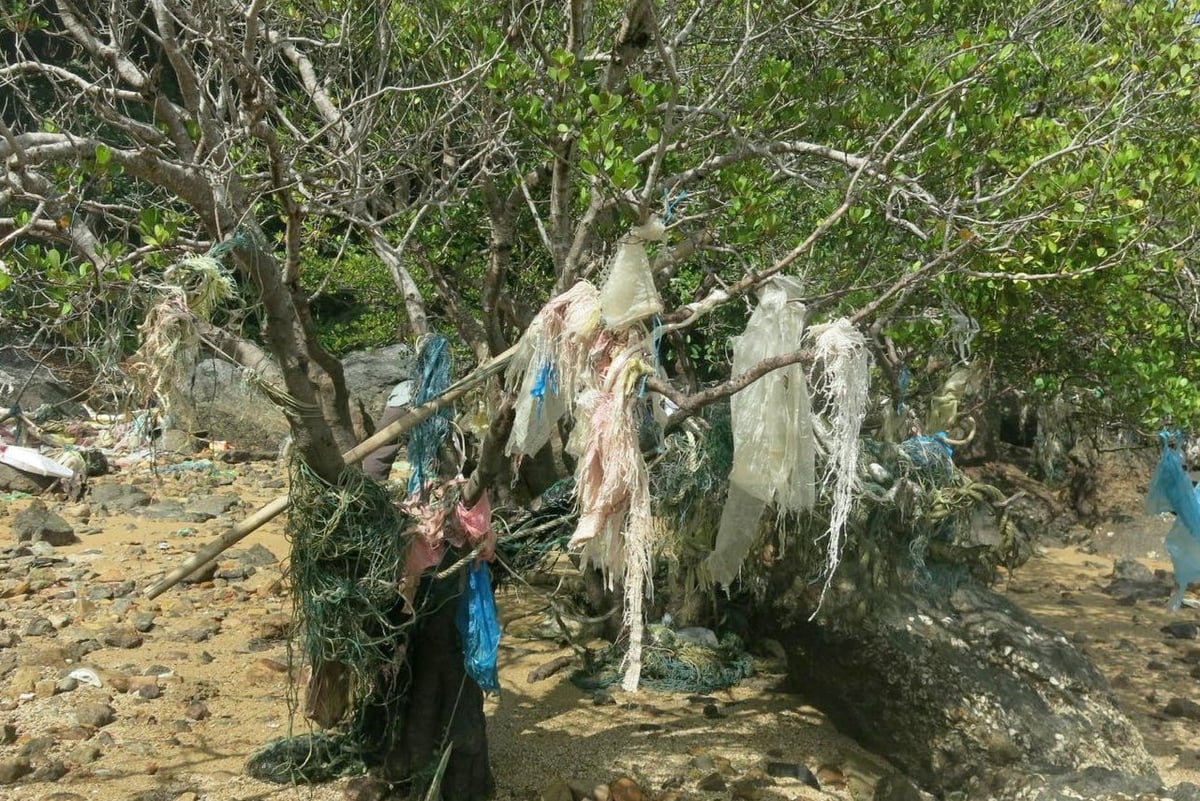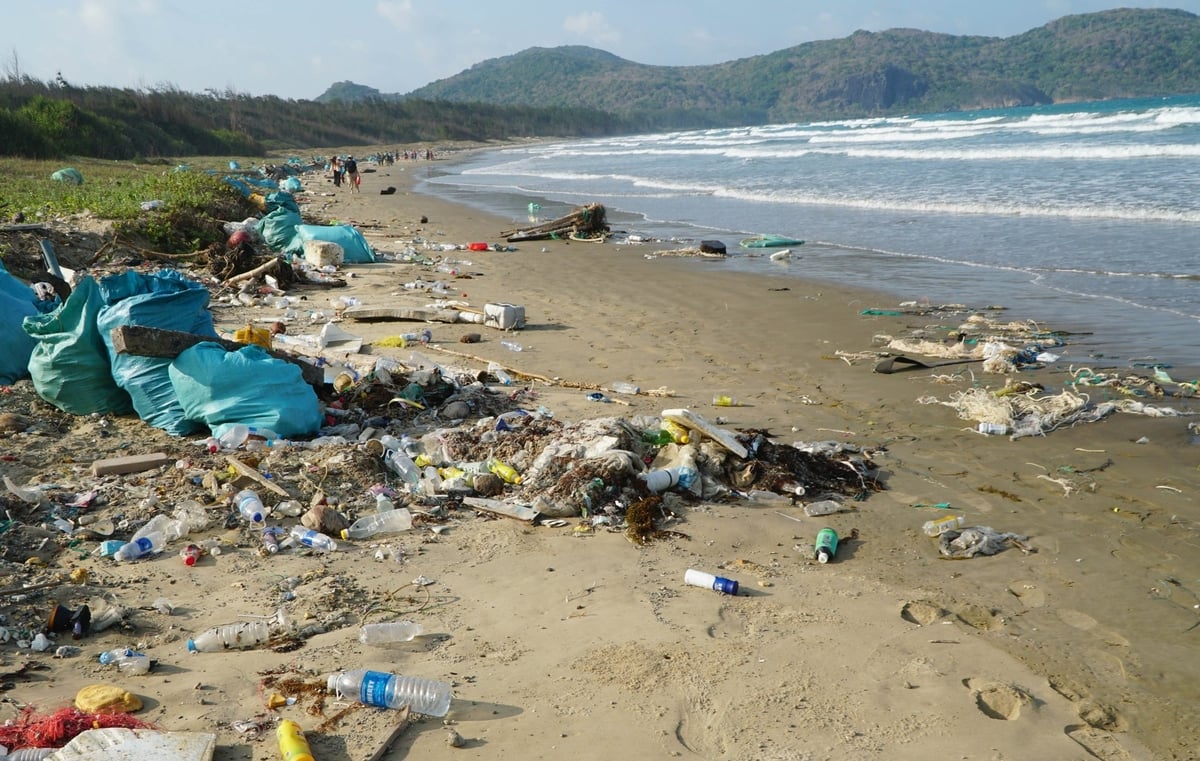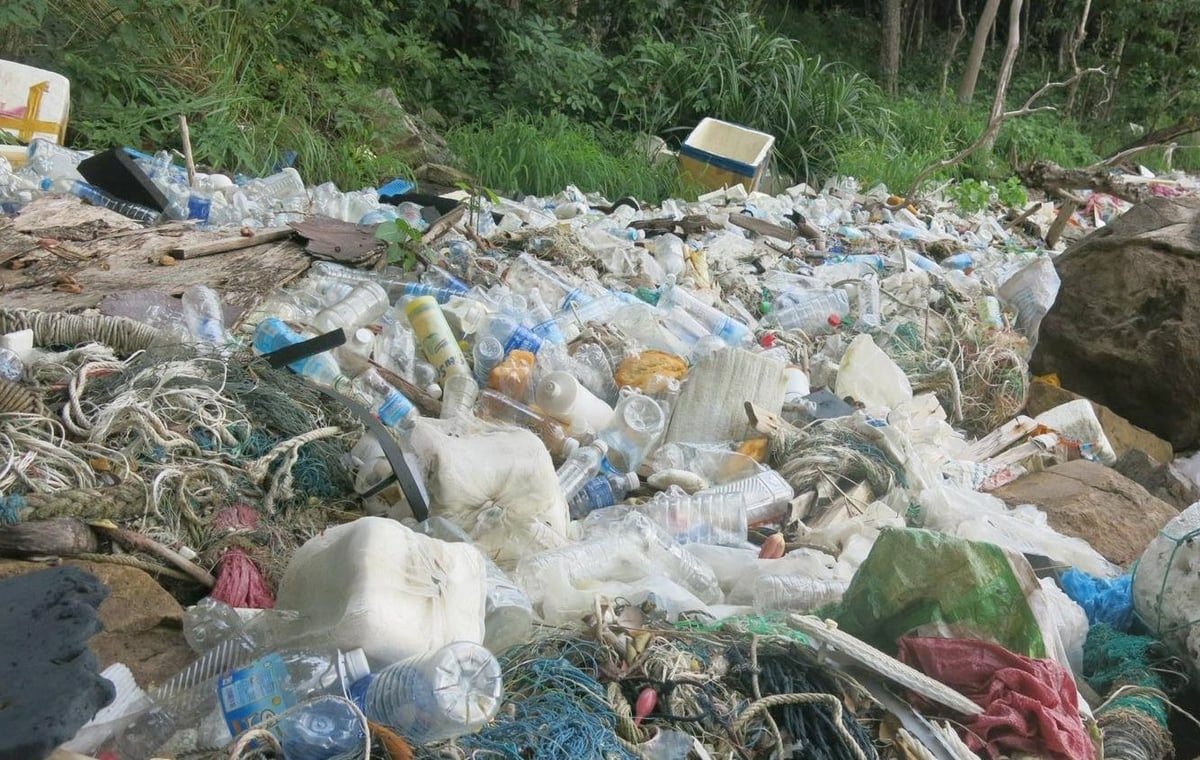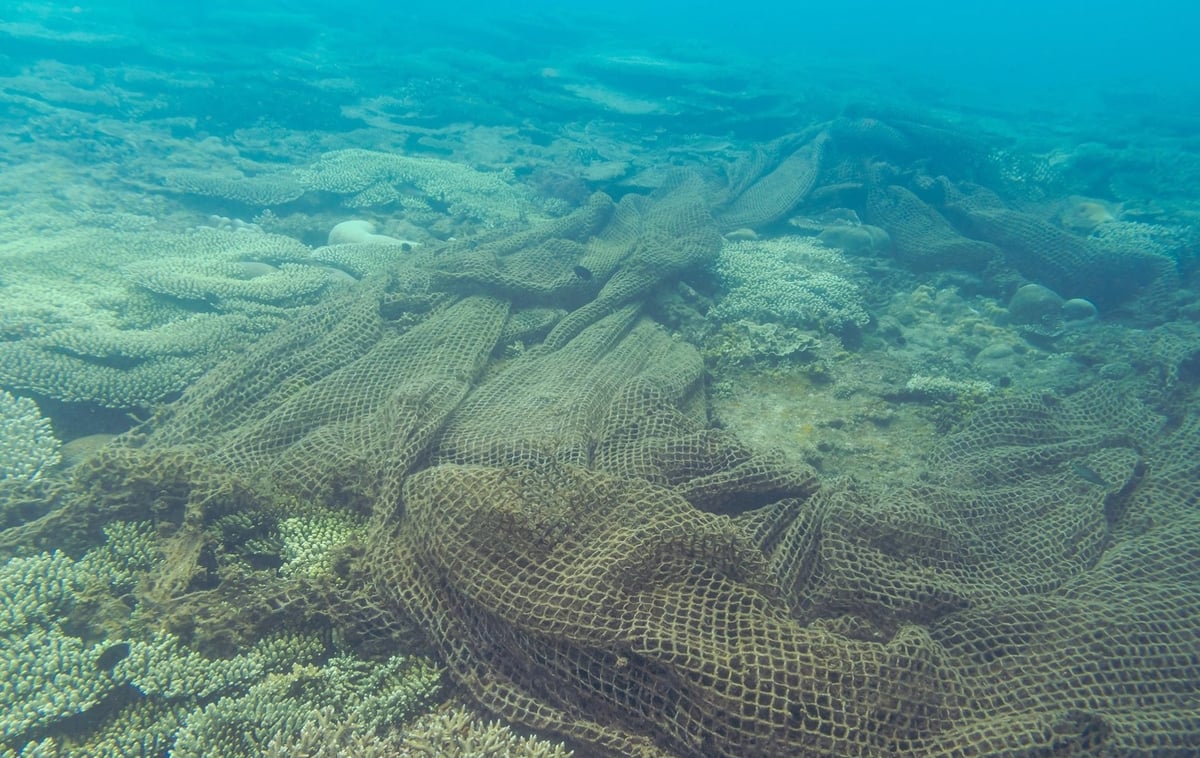October 20, 2025 | 23:50 GMT +7
October 20, 2025 | 23:50 GMT +7
Hotline: 0913.378.918
October 20, 2025 | 23:50 GMT +7
Hotline: 0913.378.918
Located on the eastern side of the Con Dao archipelago, Bay Canh Islet is surrounded by vast primary forests rich in diverse flora and fauna. It is also the most important nesting site for sea turtles in Southeast Asia, with the highest number of turtles coming ashore to lay eggs each year.
However, Bay Canh islet has also become a hotspot for ocean waste, with large amounts of debris washing ashore. Trash piles up on the beaches, gets stuck in rock crevices, tangled in tree roots, and in some cases, is even swept deep into the forest by waves. As a result, collecting and managing waste, as well as cleaning the marine environment on Bay Canh, has become an ongoing priority.

Bay Canh Islet is one of the areas most severely affected by ocean waste spanning from the shoreline and seabed to the surrounding forest. After each tidal cycle, it’s not uncommon to see debris hanging from the trees, carried in by the waves. Photo: Le Hong Son.
From 2020 to 2025, the project "Reducing ocean plastic waste in Vietnam" implemented in Con Dao by WWF in coordination with the Vietnam Administration of Seas and Islands, has collected a total of 151.8 tons of ocean plastic waste. On average, approximately 0.15 tons of plastic are retrieved from the sea each day. It is estimated that each year, organizations operating in the Con Dao special zone collect and process between 30 to 36 tons of marine plastic waste.
Most of the collected debris includes plastic bags, ropes, broken fishing nets (also known as abandoned nets), plastic bottles, beer cans, and shattered foam containers. Much of this waste is deeply lodged within coral reefs or entangled in the roots of mangrove trees along the island’s shores.
The southwest monsoon, which lasts from June to September each year, exacerbates the problem turning Con Dao into a catchment zone for marine debris from across the region. Many plastic bottles bear labels in Thai, Chinese, or even Khmer, indicating that the trash is not just from Con Dao, but from surrounding countries as well. According to a WWF survey in 2020, Con Dao recorded the highest marine plastic density among Vietnam’s 11 marine protected areas, with an average of 62 plastic fragments and 1.3 kilograms of plastic waste per meter of coastline.
One particularly alarming issue is abandoned nets or fishing nets left drifting in the sea, which have become invisible death traps for marine life, especially sea turtles. According to the Con Dao National Park Management Board, from 2021 to now, at least 14 cases of turtles caught in ghost nets have been recorded, with five confirmed deaths due to drowning or severe injuries.

According to WWF, approximately 32.4 tons of waste are discharged into the ocean from Con Dao each year. Photo: Le Binh.
Mr. Nguyen Khac Pho, Director of the Con Dao National Park Management Board, remarked: "Abandoned fishing nets have become silent killing machines on the ocean floor. No one controls them, no one retrieves them, yet they continue to cause harm every single day."
During numerous diving surveys, coral clusters around nearshore reefs such as Hon Tre Lon and Bay Canh Islet have shown signs of being “blanketed” in plastic waste and ghost nets. The sea has long brought great value to local fishermen through marine harvesting, but at the same time, many fishermen are unintentionally abusing the ocean through careless and unsustainable practices.
Among the abandoned nets left drifting at sea, many come from local fishermen - those who, often unknowingly, have become part of the pollution cycle.
Mr. Tran Van Phong, 54, a veteran fisherman living near Ben Dam Port, admitted candidly: "In the past, we thought it was normal if a net tore, we’d just cut it and toss it away; if a foam box broke, we’d dump it into the sea to lighten the boat. Everyone did it, and it became a habit. But now, seeing turtles dead and fish trapped in nets, we realize how wrong we were."
The habit of discarding damaged nets, foam containers, and daily waste into the sea was once a deeply troubling issue. Due to the nature of long offshore fishing trips and a lack of onboard waste collection facilities, many fishermen resorted to throwing waste overboard out of convenience.

Some of Con Dao's most beautiful beaches such as Dam Trau and Bai Nhat have, on numerous occasions, been blanketed with drifting waste, including plastic bottles, ghost nets, broken foam, and even industrial plastic debris from various countries. Photo: Le Binh.
According to a 2023 report by the Con Dao District People’s Committee at the time, approximately 60 -70% of the marine waste around the island originated from fishing activities and daily life on boats. Among the most common items were old nets, fishing lines, foam containers, and plastic water bottles.
However, change is gradually taking place. Following multiple awareness campaigns by local authorities and WWF, a number of fishermen have begun to shift both their mindsets and behaviors.
Local authorities have also introduced various incentive policies to encourage fishermen to keep the sea clean, such as: covering waste collection costs, distributing free garbage sacks, and organizing programs where waste can be exchanged for essential goods. In addition, the Con Dao National Park is developing a pledge titled “No Littering, No Abandoned Nets,” to be signed by all fishing boats registered to operate within the marine protected area.
Many fishing vessels have voluntarily begun carrying trash bags on board, committing not to dump waste at sea and instead bringing it back to shore for proper disposal. Much of the plastic waste collected during these trips is now being delivered to the rebirth zone for recycling.
Mr. Tran Thanh Huyen, Vice Chairman of the Con Dao Special Zone People’s Committee, stated: “To truly solve the problem of marine waste, the role of fishermen is indispensable. They don’t just live off the sea, they must become its stewards.”

Nets abandoned by fishermen are present at many coral reefs, suffocating the marine ecosystem beneath the ocean. Photo: Nguyen Van Vung.
However, many challenges remain. Some fishermen remain reluctant to change their practices, believing that waste management is too burdensome. Their boats are often small and cramped, lacking safe storage space for trash. In addition, enforcement of littering regulations is still weak. There is a shortage of monitoring equipment and insufficient resources for regular inspections.
From coral reefs choked beneath the waves to sea turtles dying silently after becoming entangled in fishing nets, ocean waste is leaving deep scars on Con Dao’s fragile ecosystem. Yet amid these struggles, a few pioneering individuals within the local fishing communities are beginning to lead the way toward change.
To keep Con Dao green, short-term underwater clean-up campaigns are not enough. What’s needed is a long-term strategy. One can include policies to help fishermen change their habits, stronger oversight of fishing-related waste, and the creation of truly sustainable “fishermen protecting the sea” models.
Because only when fishermen become allies of the ocean can sea turtles swim safely among the reefs, and ghost nets stop their silent killing.
Translated by Kieu Chi
/2025/10/20/3709-1-152351_150.jpg)
(VAN) The ASEAN Entrepreneurial Excellence Award has been presented to Labor Hero Thai Huong, Founder of TH Group, in the context of Vietnam undergoing a strong transformation.

(VAN) When the government, scientists, and businesses work together in close collaboration, research and applications in biotechnology can truly innovate.

(VAN) Vietnam is facing major opportunities with gene-editing technology, yet the lack of a legal framework has kept many promising studies confined to laboratories.

(VAN) As many Asian countries has adopted flexible management of gene-edited crops, Viet Nam still lacks clear regulations, holding back the rise of this transformative technology.

(VAN) Vietstock 2026 promises to be a dynamic platform for knowledge exchange, business networking, and collaboration among industry professionals, aiming to foster innovation and sustainable development across the livestock value chain.

(VAN) After the merger, An Giang has strengthened management, advanced technology adoption, and institutional improvement to sustainably develop its clean water system and ensure safe water for local residents.

(VAN) With its bright, green, and clean learning environment, Nhon Nghia Primary School in Can Tho is integrating education with real-life experiences, nurturing environmental awareness among its students.